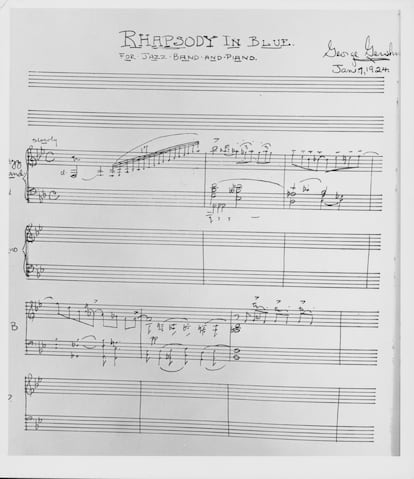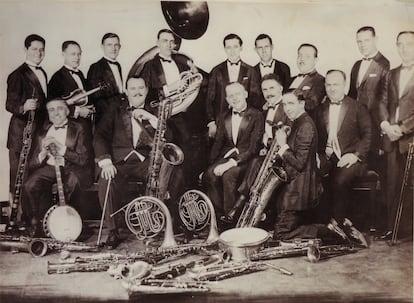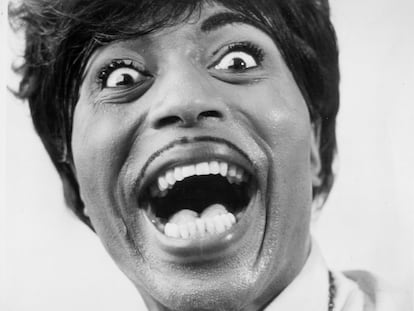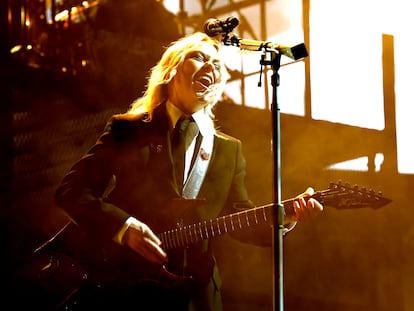One hundred years of ‘Rhapsody in Blue,’ a composition that changed music history
George Gershwin’s work has remained popular, but it is also controversial: for some it introduced jazz into the concert hall, while others consider it to be a white musician’s crass and racist appropriation


Well-known dance music director Paul Whiteman wanted to cancel his concert on February 12, 1924. He acknowledged as much in Jazz, the autobiography he published shortly thereafter with journalist Mary Margaret McBride. But that performance at the prestigious classical concert hall Aeolian Hall in New York, which had been grandiosely announced as An Experiment in Modern Music, ended up being legendary. The idea arose from the hall audience’s delight at the inclusion of jazz tunes in a classical recital.
Whiteman chose to take this idea further than anyone else, although he was terrified of the consequences. He intended to break new artistic ground by introducing this genre of music from African American communities, then considered immoral and even dangerous, into the sophisticated classical concert hall. To that end, he put together a varied program with his orchestra of 23 multi-instrumentalists that opened with Livery Stable Blues, an example of “the true form of jazz,” and concluded with Elgar and his first march from Pomp and Circumstance, to illustrate “the scope of classical music.” But he commissioned the young pianist and composer George Gershwin to create a special work that would ideally combine both extremes.
The result was Rhapsody in Blue, a composition that changed the history of music. It is now celebrating its centennial without having lost a bit of interest or popularity. But it also remains controversial. For instance, in the pages of The New York Times on January 26, pianist and jazz critic Ethan Iverson called it “the worst masterpiece,” a “naïve and corny” composition that he compared to “the best cheesecake, or something else attractive yet unhealthy.”
That was nothing new for a composition whose overwhelming popular success always inspired criticism from both sides. On the classical side, there were doubts that Rhapsody in Blue was a composition sensu stricto, beyond a succession of melodies without formal integrity or thematic development. On the jazz side, it was always seen as a crude and even racist appropriation by Gershwin (a white musician of Jewish origin) of a language that did not rightfully belong to him, a paradigmatic example of fake jazz, the commercial success of which ended up eclipsing the real thing.
Although the concert at Aeolian Hall was a resounding triumph, Whiteman himself compiled the negative reviews in his autobiography. In the pages of The New York Times, Olin Downes accused him of being a piece of jelly that trembles more than leads, while in The New York Herald, Lawrence Gilman considered the rhythm and instrumental coloring of Rhapsody in Blue novel but found its melodies and harmonies weak and conventional.
He also recalls that many of the city’s leading classical artists attended this concert, including singer Amelita Galli-Curci, pianist and composer Sergey Rachmaninov, violinist Fritz Kreisler and conductor Leopold Stokowsky. He remembers that, despite the snowfall that day, there was no shortage of fights and pushing and shoving to gain access to the concert. And he reports his financial fiasco, since he could have sold ten times the capacity of the hall, but he ultimately lost about $7000 (over $100,000 today).
Today, no one doubts that Rhapsody in Blue made Gershwin a pioneer capable of transcending the supposed musical divide between popular and classical music. Richard Crawford underscores that point in his biography of the composer, Summertime: George Gershwin’s Life in Music. The musician, who died prematurely at the age of 38, did not receive typical academic training, but he was not self-taught either. His beginnings date back to the age of 15, when he became a composer at Tin Pan Alley and, in 1914, he got a job as a song salesman at the Remick publishing house. There, he befriended a teenager named Fred Astaire, who worked as a song plugger, and the two shared their dreams of a future in musical comedy.

Beginning in 1920, Gershwin’s career got a decisive boost when he started composing the music for George White’s Scandals. This series of Broadway revues allowed him to develop the future language of Rhapsody in Blue. Whiteman and his orchestra joined the 1922 revue, and that same year Gershwin wrote a verismo-style jazz-opera in one act, entitled Blue Monday, a 20-minute-long number. A New Haven critic considered it to be “the first truly American opera set to music in the popular vein.” He was referring to the use of four native genres: jazz music, sentimental song, blues, and ragtime.
That would be the seed of his 1935 black folk opera, Porgy and Bess. But it was also the expressive axis of his first major instrumental composition, which is now 100 years old. At first, Gershwin did not accept Whiteman’s commission, but the conductor convinced him with an advertisement in the press. Years later, in his 1931 biography, the composer confessed to Isaac Goldberg that the main purpose of Rhapsody in Blue was to demonstrate that jazz should not cling to the strict pulse of dance rhythms. To that end, Gershwin threw in a number of blues song melodies with varied rhythmic territory until he achieved a freer, more unpredictable music. He told Goldberg that one of the melodies came to him while traveling by train to Boston, where he had another epiphany in which he contemplated the whole piece in his mind.

But Rhapsody in Blue was also a composition that had other contributors. We know that Ira Gershwin, George’s brother and lyricist, Ira Gershwin, came up with the title as he contemplated James McNeill Whistler’s painting Nocturne: Blue and Silver - Chelsea and connected the work’s tonal vocabulary based on blues music to the experiment of connecting Franz Liszt’s form with Jelly Roll Morton’s style. He originally wrote the composition for two pianos, and its instrumentation was done by Ferde Grofé. We also owe this composer the idea of presenting the lyrical and expressive central theme of the work three times, first in the strings, then with the full orchestra and finally with the piano. Grofé would later write two more orchestrations of the work: in 1926, for a small orchestra and, in 1942, for symphony orchestra, which is the most common version in concert halls. And its famous opening, with that spectacular, jazzy clarinet glissando rising two octaves and a fourth, was devised by Ross Gorman, the clarinet soloist in Whiteman’s orchestra.
Gershwin recorded Rhapsody in Blue for the Victor label with Whiteman’s orchestra in June 1924, and sales of the record reached one million copies. It was the first of hundreds of records to come, as well as the beginning of the piece’s intense reception, which pitted the new composition’s popularity against the emerging American musical modernism, which soon elevated Aaron Copland over Gershwin, as Carol J. Oja’s research revealed. The most influential critics, such as Paul Rosenfeld and Virgil Thomson, described Copland as an artist who elevated jazz to the status of art, while Gershwin kept it at the basic level of popular entertainment.
The success of Gershwin’s 1924 experiment eventually overshadowed everything. His attempt to bring jazz into the concert hall prevailed over the contemporary and later achievements of American modernist composers, such as Copland, and even true African American musicians like William Grant Still and Duke Ellington. Thus was born the controversy around Rhapsody in Blue, which intensified with the interest it aroused among leading European composers of the day, such as Ravel, Bartók and Stravinsky.
A comment from a composition professor at Manhattan’s Mannes School of Music stands out among the responses to Iverson’s recent anti-Rhapsody in Blue article in The New York Times. The article made the professor listen to Gershwin’s work again and marvel at its formal miracle, which he compares with Stravinsky’s The Rite of Spring. In fact, the New York premiere of the Russian composer’s controversial work took place at Carnegie Hall exactly two weeks before Gershwin’s work did. And responses to the two compositions were related; some critics even understood Rhapsody in Blue as the New World’s answer to Stravinsky. Gershwin had become the first American composer who could measure himself against a European titan.
Sign up for our weekly newsletter to get more English-language news coverage from EL PAÍS USA Edition
Tu suscripción se está usando en otro dispositivo
¿Quieres añadir otro usuario a tu suscripción?
Si continúas leyendo en este dispositivo, no se podrá leer en el otro.
FlechaTu suscripción se está usando en otro dispositivo y solo puedes acceder a EL PAÍS desde un dispositivo a la vez.
Si quieres compartir tu cuenta, cambia tu suscripción a la modalidad Premium, así podrás añadir otro usuario. Cada uno accederá con su propia cuenta de email, lo que os permitirá personalizar vuestra experiencia en EL PAÍS.
¿Tienes una suscripción de empresa? Accede aquí para contratar más cuentas.
En el caso de no saber quién está usando tu cuenta, te recomendamos cambiar tu contraseña aquí.
Si decides continuar compartiendo tu cuenta, este mensaje se mostrará en tu dispositivo y en el de la otra persona que está usando tu cuenta de forma indefinida, afectando a tu experiencia de lectura. Puedes consultar aquí los términos y condiciones de la suscripción digital.
More information
Archived In
Últimas noticias
The new victims of the Republican war on Obamacare: Millions hit by soaring health insurance premiums
A country divided on migrant rights: Some US states expand protections while others restrict them
Venezuela authorizes the release of another 87 political prisoners
There is as much life left to discover on planet Earth as that which is already known
Most viewed
- David King, chemist: ‘There are scientists studying how to cool the planet; nobody should stop these experiments from happening’
- Reinhard Genzel, Nobel laureate in physics: ‘One-minute videos will never give you the truth’
- Oona Chaplin: ‘I told James Cameron that I was living in a treehouse and starting a permaculture project with a friend’
- Sinaloa Cartel war is taking its toll on Los Chapitos
- The Interoceanic Train, the Mexican alternative to the Panama Canal










































